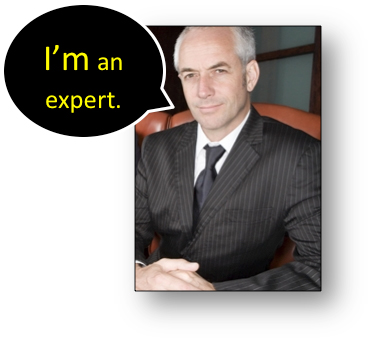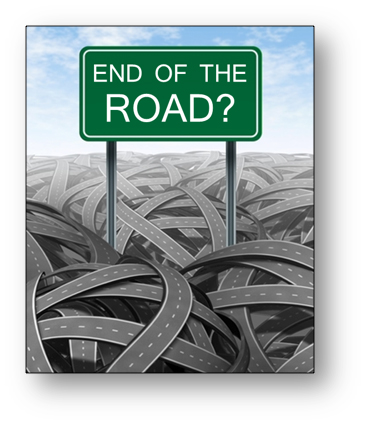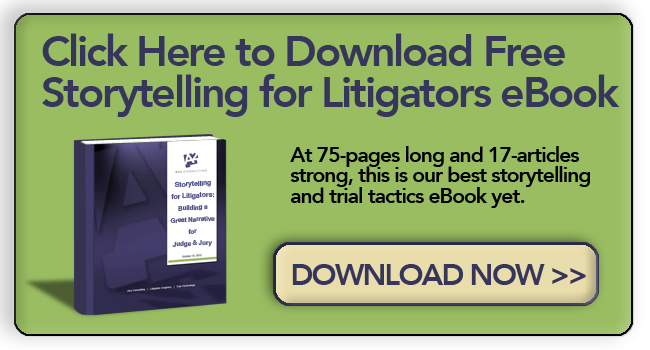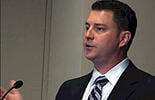by Ryan H. Flax, Esq.
(Former) Managing Director, Litigation Consulting
A2L Consulting
This seems to be a significant hurdle in many cases – trial counsel believes he or she needs assistance with the courtroom presentation, trial technology, and/or jury consulting, but doesn’t know when the right time to get started with the process is (or doesn’t fully consider this need until it’s become an “emergency”). Holding-back their decision are uncertainties about costs, about what exactly the litigation and jury consultants can and will do to help, how long the process should take, and how definite the trial strategy must be to fire the proverbial starter pistol. Let me clear it up: it’s never too early (or too late).
There are many logical starting points to engage litigation consultants during the lifespan of a case. Let’s take a look at some of them below:
1. Trigger: Complaint (Call Your Litigation Consultants Right Away)
I’m not suggesting you need to seek a litigation consultant to serve your complaint or file the answer, BUT per my (previously published) recommendation that you use a two-track litigation plan in developing your trial strategy, it is important to begin planning your courtroom presentation very soon after these litigation-initiating events and a litigation consulting team will benefit this process. That two-track strategy includes: (1) preparing to persuade a jury and/or judge so you can win the trial; and (2) doing all the really “lawyery” stuff like establishing a comprehensive record, meeting your prima facie case, etc., that becomes very important at summary judgment or on appeal.
The benefits of engaging a litigation consulting firm like A2L early in your case is that it forces you to think about those things that will help you win at trial. These include developing the foundational story of your case, identifying complexities of the case that must be simplified and distilled so that a jury of lay-people will understand and be persuaded by your arguments, and developing an understanding of your jury pool’s demographics and tendencies so that your case can be built around that knowledge. Moreover, you can begin developing the visual component to your case, which has been conclusively and scientifically proven [pdf] to be a key aspect of litigation persuasion.
Another important reason to start early is your litigation budget. At the beginning stages of every case you have the opportunity to build into your budget all the things that will help you win (attorney and paralegal time, electronic database storage, discovery software, war-room facilities, jury research, litigation consulting and demonstratives, travel expenses, court reporting and videographers, trial technology, etc.) and have your client understand and approve these things. A litigation consultant is clearly one of those things you’ll want to include and if you wait too long it will have to be an add-on cost to your case that you’ll have to get further approval for, rather than an initially planned-for, built-in line item cost. Plus, explaining this litigation need to your client early in the case reinforces the fact that you’ve got the experience to handle his/her case – you know all the bits needed for a successful result.
Starting early like this, engaging the consultant and having them begin some preliminary work on your case, doesn't really increase costs. The counsel-consultant relationship can be kept at a low simmer over the course of the months (or years) of litigation. You can seek consult on issues as you move along, e.g., test storylines on an outside player, develop graphics to use in briefing or discovery or hearings or settlement negotiations, do early jury research.
Eventually, as you get closer to trial, you’ll turn up the heat for more trial-relevant and essential input from your consultant and to develop demonstratives to use at trial.
See also:
- Sample One-Year Trial Prep Calendar for High Stakes Cases
- The 14 Most Preventable Trial Preparation Mistakes
- 5 Surprising Areas Where Geography No Longer Matters in Trial Support
- Trial Graphic: Could a Wall Chart Change How Litigators Prep Cases?
- Free Download: The Complex Civil Litigation Guidebook
2. Trigger: Expert Reports (Call Your Litigation Consultants About 1 Month Before Service is Due)
 Discovery is often a time during which the end-goals of litigation can be forgotten or at least swept to the side while attorneys build the heap of facts they’ll later use to try and convince some regular folks that their legal case is better than opposing counsel’s legal case. Try not to do this. Your case themes and developing storyline should, in part, direct your discovery requests, discovery review, and depositions. Engaging a litigation consulting team will help keep you tuned in to these important aspects of your case.
Discovery is often a time during which the end-goals of litigation can be forgotten or at least swept to the side while attorneys build the heap of facts they’ll later use to try and convince some regular folks that their legal case is better than opposing counsel’s legal case. Try not to do this. Your case themes and developing storyline should, in part, direct your discovery requests, discovery review, and depositions. Engaging a litigation consulting team will help keep you tuned in to these important aspects of your case.
In most big litigation, expert witnesses are a very big part of the discovery process and, ultimately, trial. First you’ll likely have expert reports to (help) prepare and then you’ll have expert depositions to take (unless you want to try and restrict the expert’s testimony to his/her report’s disclosure for some reason). Expert reports are opportunities to use visual support in the form of graphics, animations, or scale models to enhance your expert’s positions. To do this you need assistance from your litigation consultant who can work with you and your expert to develop persuasive visuals that compliment your case and the expert’s opinions.
Expertly crafted demonstratives can be embedded within an expert report or, if they are large and detailed images, more advanced animations, or even scale models, they can be appended as exhibits to the report. Taking the time to prepare these things for your expert paves the way to using them without reasonable objection at trial (see FRCP 26). Additionally, going through this process of thinking through how to visually convey his key messages engages your expert in a way more akin to the way he’ll have to think at trial – where his goals will be persuasion through education.
What follows the production/exchange of expert reports? Expert depositions.
Unless your expert is an expert at testifying, he likely needs some work to get him in good form to testify. Many attorneys handle this exercise themselves by reviewing the expert’s report with him, explaining the deposition process, explaining the dos and don’ts of being deposed, etc., but often this is not enough. You may choose to do as I did when I was trying cases – engage a third-party coach to help prepare your expert to be deposed. Litigation consultants (and often jury consultants) can provide outside expertise in preparing your witness. As third parties to the case, consultants can play the “bad guy” more easily than can members of the attorney litigation team. Many times, it’s this “tough love” that turns a novice expert “disaster” into the key piece of the puzzle that wins the day at trial (or doesn’t lose the day at deposition).
All this means that in the weeks leading up to expert reports coming due, you should consider pulling the trigger and calling in your litigation consulting team.
See also:
- Witness Preparation: Hit or Myth?
- The Top 14 Testimony Tips for Litigators and Expert Witnesses
- The Jodi Arias Trial, A Case Study in Experts, Witness …or Witless?
- 7 Things Expert Witnesses Should Never Say
- Free Download: A Guide for Jury Consulting for Litigators
3. Trigger: Settlement Conference (Call Your Litigation Consultants About 1 Month Before)
This, too, is a good time to get going with your trial preparation. A lot of clients contact us at this point because they want to have a sort of Closing-Argument-Lite to show opposing counsel how strong their case is and how weak the opposing case is.
 You’ll want to use a professional litigation graphics firm to help for two reasons: (1) you want this presentation to effectively convey the story you want it to convey so that your argument seems super reasonable, persuasive, and imminently winnable; and (2) you want your litigation graphics to look “sophisticated” so that your opposing counsel sees how seriously you’re taking the case and how much time and money you and your client are willing to spend on it.
You’ll want to use a professional litigation graphics firm to help for two reasons: (1) you want this presentation to effectively convey the story you want it to convey so that your argument seems super reasonable, persuasive, and imminently winnable; and (2) you want your litigation graphics to look “sophisticated” so that your opposing counsel sees how seriously you’re taking the case and how much time and money you and your client are willing to spend on it.
In reality, it is not expensive to prepare this short presentation and the time, money, and effort is all well-spent if it moves your opposition. Consider the cost balance in this scenario: if you believe settlement is reasonable, but you cannot convince opposing counsel to do so on favorable terms and have to continue through trial it will likely cost your client hundreds of thousands, If, on the other hand, you prepare a persuasive settlement presentation at this point for less than 5-10% of such costs and your presentation is effective in accomplishing the settlement on your terms, you’ve saved your client those hundreds of thousands of dollars. Even if you don’t settle at this point the costs are not lost because you’ll likely re-use much of the litigation graphics or versions thereof later in the case.
See Also:
- 14 Places Your Colleagues Are Using Persuasive Graphics (That Maybe You're Not)
- 7 Reasons In-House Counsel Should Want a Mock Trial
- 13 Revolutionary Changes in Jury Consulting & Trial Consulting
- 9 Things Outside Litigation Counsel Say About In-house Counsel
- Free Download: Using Litigation Graphics to Win
4. Trigger: Dispositive Motions or Markman Hearing (Call Your Litigation Consultants About 2-3 Months Before)
There comes a time in every case where it can end on a motion and this is an important time to have a litigation consulting team available to help make sure your briefing, argument, and presentation are everything they can be.
 In all cases there are typically motions for summary judgment – this is a good time to call. In patent cases, there are also summary judgment motions, but before these there are patent claim construction hearings called Markman hearings (named after the case establishing claim construction as a matter of law). Both summary judgment and Markman hearings are case-pivotal, mini-trials that must be taken very seriously and litigation teams often come to A2L at this point in their cases.
In all cases there are typically motions for summary judgment – this is a good time to call. In patent cases, there are also summary judgment motions, but before these there are patent claim construction hearings called Markman hearings (named after the case establishing claim construction as a matter of law). Both summary judgment and Markman hearings are case-pivotal, mini-trials that must be taken very seriously and litigation teams often come to A2L at this point in their cases.
When presenting oral argument for a summary judgment hearing you will be presenting what you’ll argue is undisputed evidence and related case law on why there’s absolutely no reason you shouldn’t win the case right then and there. Your undisputed evidence will likely include documents that came right from the opposing party that prove they can’t win (in your opinion). You will also want to make some points on how all the evidence adds up to this undeniable victory for you. To do this you must have a visual component to your presentation – you want to show the evidence electronically and also graphically illustrate how it all fits together for your case. This is where a good litigation consultant and trial graphics artist, and maybe even a trial technology professional and a jury consultant, can serve you well.
In a patent case’s Markman hearing you’ll have to argue why certain language from what is likely already a complex and confusingly written patent claim means something other than what it actually says on its face. You will point to descriptions in the patent’s specification, to the patent’s drawings, to the prosecution history (and maybe to extrinsic evidence also) to make these points – you’ll need to show the court precisely where the documents prove your case and do so in a convincing way. There may also be a technology tutorial aspect to the Markman hearing required. All this makes it absolutely necessary to have a professional team available to develop persuasive visual support for your oral arguments (and briefing, too, if possible). This is likely your only chance to influence the claim construction of your case, which will likely determine the outcome at trial – make sure you do all you can to win here.
Make sure in your next case you consider these dispositive occasions to be the potential triggers to seek expert assistance for litigation.
See also:
- 11 Tips for Winning at Your Markman Hearings
- Introducing Mock Markman Hearings for Patent Litigation
- Perfecting the Patent Tutorial for Your Judge
- Free Download: The Patent Litigation Toolkit (3rd Edition)
5. Trigger: Trial is Scheduled (Call Your Litigation Consultants About 6 Months Before)
OK, now things are getting pretty serious. Trial dates are moved all the time in litigation, but if your case is scheduled for 6-months out, it’s likely that’s when you’re going to trial. At this point, if you’ve waited to engage an outside consultant to help you prepare your trial presentation, this is the time to pull that trigger.
 Doing so with 6 months to spare enables you and your new litigation consulting team to develop a strategy around jury research, develop convincing and relatable trial story lines, figure out what visuals are needed, etc. With 6 month to go, you still also have time to do mock jury exercises, but that time is quickly slipping away so start planning immediately. With 6 months to go you can have your litigation consultants fully engaged and supplying you with fresh, outsider’s ideas on where your case’s storylines are strong and what just doesn’t make sense. With 6 months to go you have the time to play with and tinker with your visual presentation with a bit of leisure, rather than under looming trial pressure to “just get everything done.”
Doing so with 6 months to spare enables you and your new litigation consulting team to develop a strategy around jury research, develop convincing and relatable trial story lines, figure out what visuals are needed, etc. With 6 month to go, you still also have time to do mock jury exercises, but that time is quickly slipping away so start planning immediately. With 6 months to go you can have your litigation consultants fully engaged and supplying you with fresh, outsider’s ideas on where your case’s storylines are strong and what just doesn’t make sense. With 6 months to go you have the time to play with and tinker with your visual presentation with a bit of leisure, rather than under looming trial pressure to “just get everything done.”
If you just cannot commit to engaging a litigation consultant at an earlier stage of your case, do it now.
See also:
- 21 Ingenious Ways to Research Your Judge
- 12 Alternative Fee Arrangements We Use and You Could Too
- 10 Things Every Mock Jury Ever Has Said
- Demonstrative Evidence & Storytelling: Lessons from Apple v. Samsung
- Free Download: A Litigator's Guide: How To Find and Use Trial Technicians and Trial Technology
6. Trigger: Trial is REALLY Coming (Call Your Litigation Consultants About 1-3 Months Before)
As you can see, there are lots of other trigger points preceding your very final trial-preparation that should initiate a call to your demonstrative evidence / jury consulting / trial technician team. However, right or wrong, the majority of litigation teams wait until this end-game to get serious help in developing their trial presentation and improving their jury-persuasion strategy. It’s not the end of the world, obviously.
At this final stage of your case (baring appeal), we (litigation consultants) must be very committed to developing the specific presentations that will be made in court: opening statement, closing argument, direct testimony, and cross examination. This presentation development includes one-on-one consulting with the litigation team to sort out the best themes and storylines of your case. Events that must be conveyed to the jury to induce a perception of causation as to key issues in your case must be identified to make graphics, including timelines. If scale models are needed, there’s not much time to make them at this point so we must focus on doing so immediately. If any jury research is to be done, it’s unlikely that a full-blown mock jury exercise can be organized at this point, but you can still do smaller focus group studies or micro-mock exercises to fine tune your presentation.
Of course, a lot of litigation graphics must be produced to support (typically) an hour of opening statement, an hour of closing statement (again, typical), any visuals to support your expert(s), impeachment, litigation boards, etc. Also, if your evidence is largely electronically based you’ll need a trial tech to immediately begin developing a trial database for you and then go with you to trial to display your evidence for you seamlessly. If your courtroom is already high-tech and wired and ready to go, great; if not, you’d better arrange to have the equipment there that you’ll need to make your best presentation.
Clearly, there’s a lot to consider and waiting to the last minute is not ideal. But, if this is your situation, engage an expert to help you along this tricky path.
See also:
- 5 Questions to Ask in Voir Dire . . . Always
- 12 Reasons Bullet Points Are Bad (in Trial Graphics or Anywhere)
- 5 Things Every Jury Needs From You
- 16 PowerPoint Litigation Graphics You Won't Believe Are PowerPoint
- 6 Trial Presentation Errors Lawyers Can Easily Avoid
- Free Download: How To Use and Design Trial Timelines






Leave a Comment